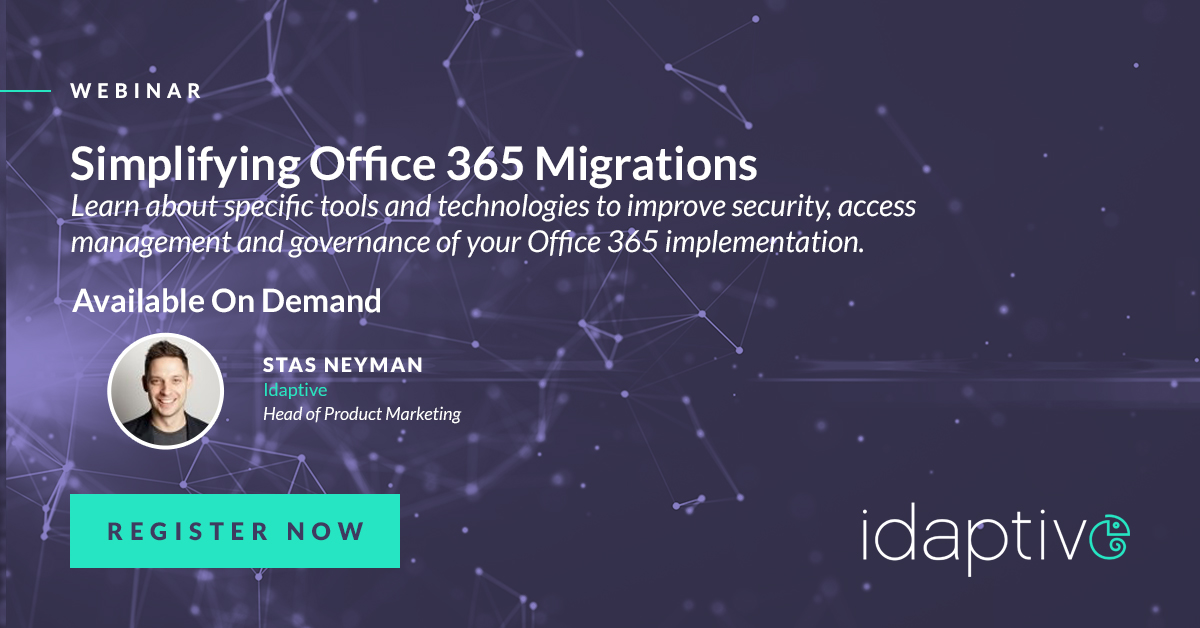Office 365 Migrations Simplified
The Top Four Takeaways From the “Simplifying Office 365 Migrations” Webinar.

The cloud evolution of Microsoft Office has made it into one of the most widely used cloud services by corporate employees. According to Microsoft1, Office 365 has over 180 million users, and the adoption rate is significantly outpacing that of Google G Suite2.
But as organizations turn to Office 365 for collaboration and security benefits, many are running into challenges during the migration process. For example, companies need to figure out how to integrate Active Directory with cloud-based single sign-on, manage user provisioning and entitlements, and enable remote workers to access Office 365 apps securely.
So how do you address these challenges, reduce the overall deployment complexity, and keep your users productive? To put it simply, you need the right set of tools and a comprehensive migration plan.
We covered both the tools and the planning process in our Simplifying Office 365 migrations webinar. You can watch the entire webinar on-demand, but here is a recap of the top takeaways to simplify your migration journey:
1) Start with a deployment plan
One of the first decisions you’ll need to make is on the authentication method, and specifically where the user authentication will take place. There are a few deployment options available, including cloud-only, hybrid, or federated identity — make sure to familiarize yourself with the pros and cons of each. Your deployment plan should also specify the Directory that will be your source of truth for users, what you’ll do about provisioning, and how you’ll manage user licenses.
As a word of advice, it’s always a good idea to approach Office 365 migration in phases. For example, your Phase One can start with your Active Directory as your “source of truth.” During this phase, you can use an identity and access management platform like Idaptive as your authentication mechanism. In Phase Two, you can add provisioning to streamline your onboarding processes and multi-factor authentication (MFA) to secure users’ Office 365 accounts. Finally, in Phase Three, you can remove all dependencies on Active Directory and leverage the Idaptive Cloud Directory as your “source of truth.”
2) Think about the now versus the future
Another good practice (for any IT initiative really) is to assess your current requirements against your end goals. Just because a solution that you’re considering now meets your requirements today, doesn’t mean that it will meet your needs in the future. Additional investments might be necessary to get you there, and that takes us to another key element to keep in mind during IT adoptions…
3) Be aware of hidden costs and timelines
Always consider all the costs. There are numerous examples of technologies that — in the long run — become a burden to maintain. While at first they might provide the expected value, it’s important to think about how to “future-proof” your investments in technologies and whether the ends will justify the means. It’s crucial to determine the initial or upfront costs as well as the long-term costs, especially when it comes to hardware and IT overhead.
4) Determine security requirements
Last, but certainly not least (and perhaps most important in the era of data breaches), make sure you think through all the security implications. This includes all existing and future threats, which is easier said than done. By considering things like MFA, passwordless authentication, or what it means if a user Directory is being replicated in the cloud, you can better assess your current security posture and take the right steps to enhance security using a Zero Trust method. Idaptive takes the legwork out of this.
Using Idaptive, you can provide business users with seamless access to cloud services like Office 365 — as well as traditional on-premise apps — from anywhere they’re working, without the need for a VPN. Users simply enter their AD credentials to access a personalized web portal, which contains all of their assigned applications in one place. The portal also allows users to reset forgotten passwords, manage their registered mobile devices, and request access to additional apps, improving the overall user productivity.
For IT, that means improved security across the board and fewer help desk tickets to reset forgotten or compromised passwords. To further reduce the risk of compromised credentials, you can leverage Idaptive Multi-Factor Authentication and require users to pass secondary authentication challenges to gain access to Office 365. Idaptive supports a comprehensive range of authentication methods to make it easy for your users to securely access Office 365 applications and data. With Idaptive, you can also centrally provision your Office 365 users, manage licenses, and set up access controls to gain complete visibility into your Office 365 deployment.
In short, simplifying Office 365 migration requires Idaptive.
For more information, watch the entire on-demand webinar to learn how to create a strategy for Office 365 migration and how Idaptive can make the process seamless.


